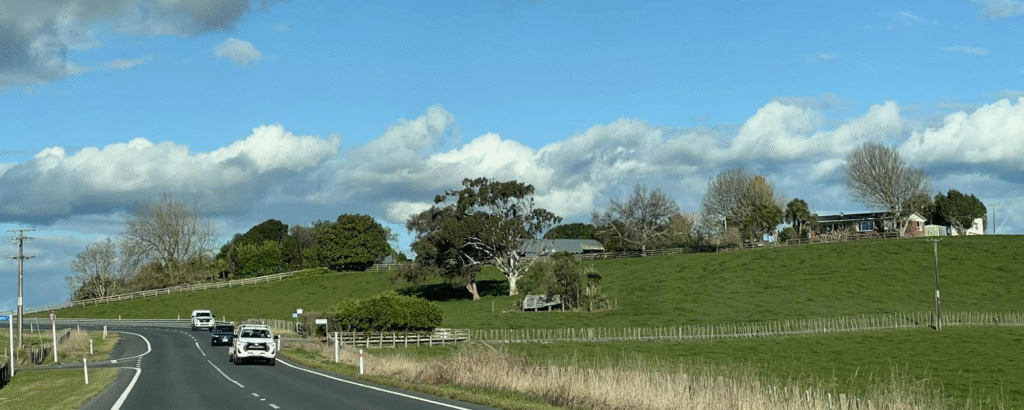
Driving is one of the best ways to explore Aotearoa – New Zealand, giving you the freedom to reach remote beaches, alpine passes, and tucked-away waterfalls. But if you’re new to our roads—or campervanning for the first time—it’s worth brushing up on some local know-how before setting off.
From unpredictable weather to narrow mountain passes, our roads offer epic scenery—but also a few curveballs. Here’s everything you need to know to drive safely and confidently across Aotearoa.
Table of Contents
Driving on the Left
In Aotearoa, we drive on the left-hand side of the road. If you’re visiting from a country where you drive on the right, it can feel a little unnatural—especially at intersections and roundabouts.
It’s easy to slip into old habits after a rest stop or hike, so stay aware, particularly when turning onto quiet roads.
➡️ Tip: Place a small note on your dashboard that says “Keep Left”—you’ll be surprised how often it helps.
When we travelled overseas, we always remembered this trick: “the centre line should be on the driver’s side”—a simple but effective way to check you’re on the correct side. And having a awesome copilot is a plus.
Speed Limits & Road Rules
Our roads may be scenic, but they’re rarely straight or fast. New Zealand’s main highway—State Highway 1—often passes through small towns and winding backroads. Don’t expect wide European-style motorways here.
- 🛣️ Open roads: 100–110 km/h
- 🏘️ Urban/residential: 50 km/h (30 km/h in school zones)
- 💺 Seatbelts are mandatory for all passengers
- 📵 Using a handheld phone while driving is illegal
➡️ Tip: If using your phone for navigation, mount it securely before setting off.
Many rental companies offer phone mounts—ask when picking up your campervan.
Rural Roads & Mountain Passes
Some of Aotearoa’s most breathtaking drives take you well off the beaten path—but rural roads come with extra challenges.
- Many roads are narrow, unsealed, or winding
- Passing lanes are limited—don’t stress, just take your time
- If traffic builds behind you, pull over safely and let them pass—you’ll often get a cheerful wave (and if not, at least you’re not holding anyone up!)
⛰️ Well-known mountain routes to research before driving:
- Crown Range Road (Queenstown – Wānaka)
- Arthur’s Pass and Haast Pass (Canterbury – West Coast)
- Skippers Canyon (4WD only and often not covered by insurance)
➡️ Tip: Google Maps often underestimates drive time. Always add buffer time and check NZTA for road alerts.
Weather Conditions
In Aotearoa, the weather can go from sunny to sideways in a matter of minutes—especially in alpine areas or on the West Coast.
- 🌧️ Check NZTA Traffic Info before hitting the road
- ❄️ In winter, ask your rental company about snow chains—they may be required in mountain areas like Arthur’s Pass or the Desert Road
- 🌊 Avoid flooded roads or fords, particularly in Fiordland and the West Coast—they rise fast and can be dangerous
➡️ Pro Tip: Always travel with warm layers, a full water bottle, snacks, and a blanket. It’s better to be overprepared in remote areas.
Bridge Crossings & Livestock
One-lane bridges are common in New Zealand, especially on secondary roads. Always check the signage:
- ➡️ Large white arrow = you have right of way
- ⬅️ Large red arrow = give way to oncoming traffic
🐄 As for livestock—yes, you may encounter cows or sheep being herded along the road, especially in rural areas.
- Slow right down
- Never honk your horn
- Let the farmer or shepherd guide you through
➡️ Personal Note: We’ve been stuck behind cows more times than we can count—just smile, breathe, and enjoy the moment. It’s part of the charm!
Avoiding Fatigue
Long driving days, jet lag, and big hikes can drain your energy fast. Fatigue is one of the most common causes of accidents among tourists.
- 🚗 Share driving if you can
- ☕ Take breaks every 2 hours—many rest areas are also scenic picnic spots
- 💤 Don’t drive after long hikes, like the Tongariro Alpine Crossing or Roy’s Peak. Your brain and body need time to recover.
➡️ Tip: If you feel drowsy, pull over and nap or stretch. It’s not worth pushing through.
Campervan-Specific Advice
Driving a campervan takes a little adjustment—especially if it’s your first time behind the wheel of something bigger.
- 🛻 Go slow on tight, narrow roads—don’t rush
- 🧱 Always be aware of overhead clearance at petrol stations, tree branches, and parking garages
- 📵 Don’t follow GPS blindly—some apps route you down unsealed or unsuitable roads
- 🗺️ Use CamperMate or Rankers NZ for camper-friendly navigation and verified road reports
➡️ Bonus tip: Check your mirror coverage—many campers have blind spots. Practice reversing and parking in a quiet spot before hitting busier areas.
Final Thoughts
Driving in Aotearoa – New Zealand is more than just a way to get around—it’s part of the adventure. With winding roads, postcard-worthy stops, and the occasional sheep traffic jam, every drive is an experience.
Stay alert, be respectful, and don’t rush. Give yourself time to enjoy the journey—safely and stress-free.
➡️ Next Up: Campervan Packing List for New Zealand – What to Bring & What to Skip
Haere tāka mua, tāka muri; kaua e whai
Be a leader not a follower